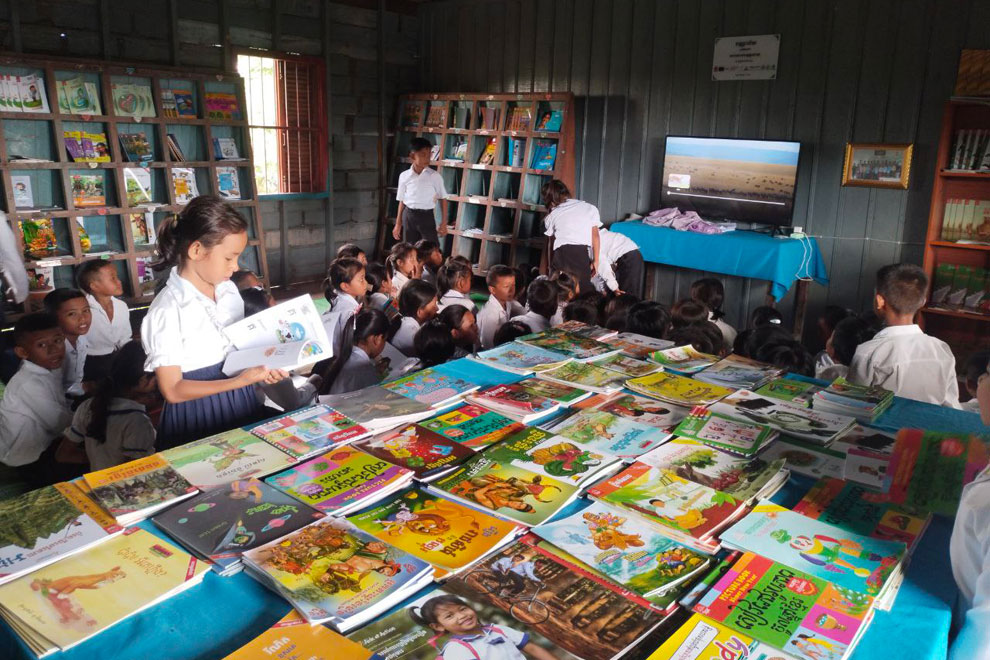
Huon Sinith (centre) and children at her library. PHOTO SUPPLIED
Most girls and boys are delighted at having access to books for reading for pleasure or studying. In one remote village in Banteay Meanchey province, there is a library which offers free access to books for children.
The facility, known as the Char Krom Village Mobile Library, is located in Char village in Preah Netr Preah district’s Prasat commune.
Most parents in the locality work abroad in Thailand or are generally occupied with agricultural tasks. Their children, who range in ages from 5 to 15 years old, use the library for reading, with two or three parents generally assisting the children at the library each day.
Hou Sinith, a 23-year-old teacher who has taught at Preah Netr Preah Primary School for the past four years, started the library in her native village in January.
Her motivation for establishing the library stemmed from the challenges she experienced in her own childhood. She recalled that due to the remoteness of the area, she struggled to access education and reading materials.
She is now determined to foster a culture of reading among the children of her village.
Another driving force behind her initiative is the inspiration she received from her mentors, who formerly worked at the Bannalai Samram, or “Garbage Library”, a small tented library that has since ceased operations due to cost considerations. There, they taught her about the many different genres of literature that are most suitable for children and young adults, as well as the necessary skills for tagging and tracking books.
Empowering future generations
Sinith explained that the primary goal of her library is to encourage a culture of reading within the village and district, and to enrich the knowledge of local children. She also aims to deter them from excessive use of smartphones or using their spare time in ways that are unproductive.
“The library is a place that inspires children to read. This not only makes them more literate, but more knowledgeable,” she said.
Sinith personally financed the establishment of the library, including the first purchases of books, as well as additional educational materials.
She said that the library has also benefited from gifts from both local and international donors. She uses their contributions for construction and maintenance, as well as additional books, pencils, pens, rulers and other educational materials.

Children show their drawings at the library. PHOTO SUPPLIED
“Encouraging children to read more books enhances their thinking skills, creativity and awareness of their environment. Reading also aids in learning the Khmer language and contributes to mental and spiritual development,” she explained.
“Colouring activities teach children about colours, foster their imagination and encourage creativity. A child who is good at colouring could potentially become an artist, an architect or an engineer in the future. Essentially, it’s about nurturing their imagination and creativity,” she added.
When asked if her establishment includes books other languages, she admits that English books have been donated but being in such a rural area, most people cannot read or write the language. Sinith said she has plans to establish an “English Corner” in the near future.
Building futures beyond the village
For her next major endeavour, Sinith plans to renovate her library. She also intends to distribute books to other villages and initiate weekly reading activities in neighbouring areas, with the goal of bringing knowledge and enjoyment to more and more children.
One of the most interesting features of her “mobile library” is that it is not mobile; the name captures the spirit of her project, if not the physicality.
“While the library isn’t technically mobile, I’ve chosen to keep the name. It reflects our ongoing commitment to extend our activities to nearby villages and communes, bringing reading opportunities and knowledge directly to the children,” she said.
Librarian Rob Ponleu, currently a grade 12 student, manages the collection in the village. She receives a modest salary from Sinith and also volunteers to teach children to read.
“At the beginning of each session, I encourage the children to sit quietly and clasp their hands, then we start with a storybook. After reading, I engage with them and ask questions, so we can discuss what we have read. The sessions also include time for colouring and playing,” she explains.
“Most children visit the library to read books. However, I am always happy to read aloud to those who cannot yet read,” she added.























